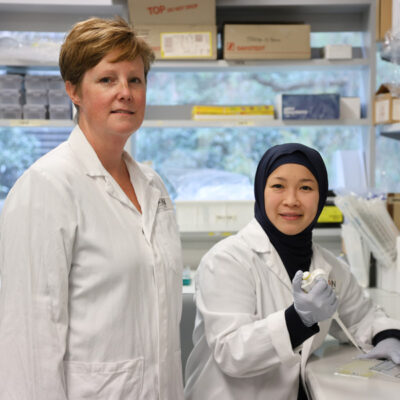Fighting a deadly pandemic
By Hudson Institute communications
Why do seasonal strains of influenza make many people sick yet cause relatively few deaths, while 40 per cent of people affected by strains of avian influenza, or ‘bird flu’, succumb to their infection?
A discovery by Associate Professor Ashley Mansell could form a strategy to protect the world’s population from a potential global outbreak of pandemic influenza.
In a paper published in The Journal of Biological Chemistry, A/Prof Mansell and his team have identified that a protein called PB1-F2, produced by a highly pathogenic strain of avian influenza called H7N9, is detected by the immune system of the infected person or animal.
“While inflammation is a normal response to seasonal flu infection, leading to symptoms like fever and aching joints, PB1-F2 induces an overzealous response and sets into motion a ‘cytokine storm’, which is often more damaging than the virus itself. The body burns up with inflammation, leading to organ failure and even death,” A/Prof Mansell explains.
“When the immune system detects PB1-F2, it triggers a highly inflammatory response by an immune sensor complex called the inflammasome. It is almost like the body’s alarm system for highly pathogenic viruses.”
Importantly, in previous studies, the team showed that targeting this inflammasome with a new drug compound could reduce the ‘cytokine storm’ in those infected during a global pandemic event.
Global potential
There is concern that strains of avian influenza such as H5N1 and H7N9 could become easily transmissible from person to person. Since 2003, when the strains first surfaced in humans, more than 2500 people in south-east and east Asia have died from these infections.
“As a global community, we live in the shadow of a severe or pandemic influenza outbreak that could devastate the world’s population. This year marks the 100th anniversary of the Spanish Influenza outbreak which infected approximately 30 per cent of the world’s population and claimed 50-100 million lives – more than both World Wars combined,” A/Prof Mansell says.
“Our ability to tackle such an outbreak is limited. There are no effective drugs to treat patients who present with fully-fledged viral infection.
“Our research may lead to a world-first approach to treat people infected with avian flu, which could prove life-saving in the event of a once-in-a-generation deadly influenza pandemic.”
Collaborators | Monash University, University of Queensland, University of Bonn, University of Massachusetts Medical School, CSIRO, German Center for Neurodegenerative Diseases, Peter Doherty Institute for Infection and Immunity.
Team | Anita Pinar, Jennifer K. Dowling, Natalie J. Bitto, Avril A. B. Robertson, Eicke Latz, Cameron R. Stewart, Grant R. Drummond, Matthew A. Cooper, Julie L. McAuley, Michelle D. Tate, and Ashley Mansell
Contact us
Hudson Institute communications
t: + 61 3 8572 2697
e: communications@hudson.org.au
About Hudson Institute
Hudson Institute’ s research programs deliver in three areas of medical need – inflammation, cancer, women’s and newborn health. More
Hudson News
Get the inside view on discoveries and patient stories
“Thank you Hudson Institute researchers. Your work brings such hope to all women with ovarian cancer knowing that potentially women in the future won't have to go through what we have!”








